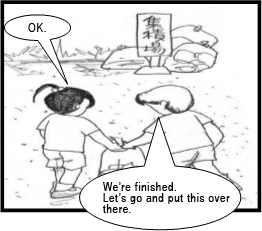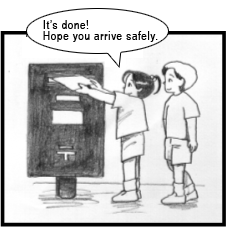For Survey Organizers
Survey of Washed-up/Buried Debris Organizer's Manual (for those in charge)
II. Conducting the Survey
1. Supervisory work including explanation to participants
(1) Before conducting the survey, carefully explain to the participants the aim of the survey, the method of the survey, the need for cooperation with the questionnaire, and points to remember (what to do in the event of injury, etc.). (Refer to Appendix 6.)
A. Aim of the survey
To gain an understanding of the state of coastal pollution by surveying washed-up debris, and to encourage environmental education through participation in the survey, by creating a common awareness toward developing the attitude not to litter and to protect the marine environment.
B. Method of the survey
Provide specific explanation of the categorization of washed-up debris using, for example, actual objects.
C. Points to remember
- Try to remove as much sand as possible from the washed-up debris on the spot.
- Do not collect plants or animals found on the beach.
- Sufficient care should be taken to avoid injury or accidents during the survey; however, in the event that they do occur, appropriate action should be taken immediately.
(2) Take photos with a digital camera of scenes before, during and after the survey.
Examples:
- Aspects such as the collection, sorting, weighing, counting of washed-up debris.
- Items from overseas, distinctive items (such as those classified as Other), etc.
- Scenes of the activity such as the collection of buried debris and removal of floating matter, and any other noticeable aspects.
(3) Clarify to participants the place to gather the collected washed-up debris.
(4) Distribute the questionnaire (refer to Appendix 7) to the participants to be filled in upon completion of the survey, and collect them. Filling in the questionnaire is helpful for the participant to reflect on their activity, and their replies are used as reference data for the next and later survey plans.
(5) Equipment for the survey is considered as specialized survey equipment and is to be stored and managed by each local government.
2. Conducting the survey of washed-up debris
The survey consists of collecting all of the washed-up debris (artificial objects only) on the ground within the 10 meter square survey block, separating it into types, and counting and weighing each type. However, detailed steps, such as the procedure and method for collecting washed-up debris, and how to record the data on the survey summary sheet, are to be finalized by each local government after adjustment.
Regarding tiny fragments, such as styrene foam, collect those with a 1-cm diameter or larger. (Collection items listed on the survey summary sheet, such as resin pellets, are to be collected even if their diameters are less than 1 cm.)
Example: Collection procedure
1) The leader divides the participants into groups (groups of 5 or more people are preferable) to work on individual survey blocks. The grouping should be done before commencement of the survey. (It is a good idea to prepare the group list in advance.)
《The following work should be carried out by all of the participants together.》
2) The leader gives each member of his/her group washed-up debris collection bags that have been prepared in advance.
3) Each member, carrying one or two bags, collects the washed-up debris (listed below) found on the sand. If the washed-up debris does not fit in one bag, use new bags as is deemed necessary.
(The washed up objects may be separated upon collection into the eight categories, or alternatively, may be collected without separating them.)
4) The leader observes the progress and instructs the other members to end the collection.
5) The leader and the other members spread the collected objects on a blue tarpaulin, etc., sorting them appropriately into the major categories (the 8 categories shown above), and prepare to count and weigh them. (In the event of bad weather said work should be conducted indoors, such as in a gymnasium.)
6) The leader has each participant thoroughly check the names of the subcategories on the survey summary sheets 1 & 2, and divide the debris into subcategories, and into those manufactured in your own country and those produced abroad, count each, and enter the results on the survey summary sheets 1 & 2 while confirming in the group the numerical order of the major categories. Write specific names on the survey summary sheet for objects that are not listed under a subcategory.
To record the figures during the survey, tally the number of articles in a blank space on the survey summary sheet, and after counting all items of the 8 categories, record the total number in the appropriate column.
Use the country of manufacture, type of writing or place names on labels, etc. to determine the country of origin. Where the country cannot be determined, record the number of articles in the column for Japan. (Refer to Appendix 8.)

7) For washed-up debris that is inferred to be from another country, record the type and number of articles by country of origin.
○ China ○ Korea/North Korea ○ Russia ○ Other (Other: articles from countries other than the 4 listed above)
Use a digital camera to take a photo of strange looking articles or those with an unknown country of origin.
8) After counting the articles in each category, divide the debris from each major category into those produced in Japan and those manufactured abroad, measure the weight of each, and record the results on survey summary sheets 1 & 2.
9) After weighing the washed-up debris, move it to a designated collection site.

3 Sending the survey results materials
The following items are to be sent to the Northwest Pacific Region Environmental Cooperation Center within one month after the survey has been completed.
(1) Maps detailing the aspects of the survey beach
1) Map detailing the borders of the entire beach
- Mark a circle in the location of the survey beach and note the survey beach code on an environmental standards type designation map or a river map.
2) Maps detailing the vicinity of the survey beach (three types)
- Mark a circle in the location of the survey beach and note the survey beach code on a 1/25,000 scale map issued by Geographical Survey Institute.
- Mark a square in the location of the survey beach and note the survey beach code on a 1/1,500 – 1/3,000 scale map (residential area map, etc.).
- Map showing the layout of survey blocks and points (a simplified map showing where washed-up debris survey blocks were set up).
(2) Survey Beach Data Sheet (refer to Appendix 1)
(3) Individual survey summary sheets and total tables, along with the electronic recording medium (such as a floppy disk) they have been put on
(Also send tables used for calculations with each row, and each survey beach. Do not change the functions in the Excel file containing the survey summary sheet.)




